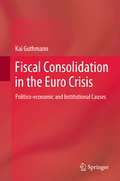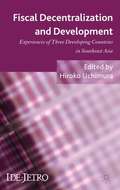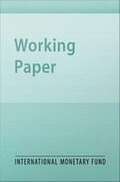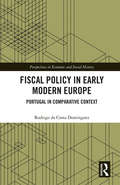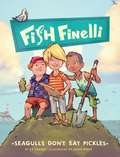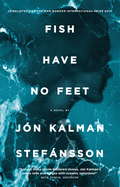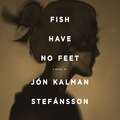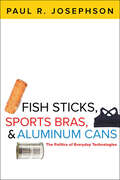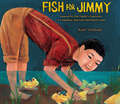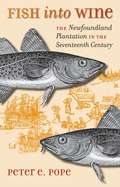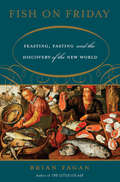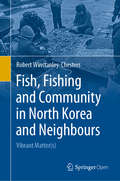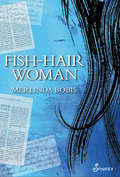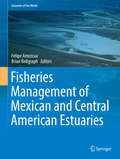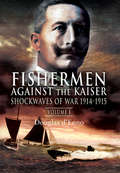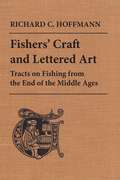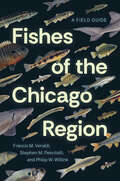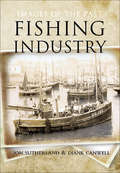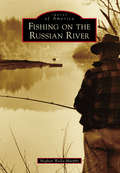- Table View
- List View
Fiscal Consolidation in the Euro Crisis: Politico-economic and Institutional Causes
by Kai GuthmannThis book sheds new light on if and why, between 2009 and 2015, European governments succeeded or failed in initiating and actually realizing some of the farthest-reaching austerity plans in modern history. The author analyzes the economic and political context and the underlying causes of austerity and economic adjustment packages during the Euro crisis. In doing so, he shows that austerity has its roots in an institutional mismatch between capitalist diversity in the Eurozone on the one hand, and an ill-conceived common economic regime on the other. In this context, austerity trumped politics, and even democracy itself. The book will appeal to scholars of political science and comparative political economy, as well as governmental policymakers and practitioners in the finance sector.
Fiscal Decentralization and Development
by Hiroko UchimuraAn in-depth analysis of the fundamental role that decentralization plays in developing countries, using detailed statistical data to examine the actual fiscal structure between tiers of government, and the effects of decentralization at the local, national and international levels.
Fiscal Monitor
by International Monetary FundIMF staff members examine the reason for the low interest rates paid for sovereign bonds issued by the U. S. and Japan, the sustainability of fiscal improvements in emerging economies, and how long it will take to lower public debt worldwide. Appendices review the theory of fiscal devaluation, analyze past privatization transactions, and track the main determinants of stock-flow adjustments over the last three decades. Color tables and graphs are provided. Annotation ©2012 Book News, Inc. , Portland, OR (booknews. com)
Fiscal Objective in the Post IMF Program World: The Case of Albania
by Jiri JonasA report from the International Monetary Fund.
Fiscal Policy in Early Modern Europe: Portugal in Comparative Context (Perspectives in Economic and Social History)
by Rodrigo da Costa DominguezThis book will examine the gradual assembly and consolidation of Portuguese fiscal policy in the second half of the fifteenth century, providing a comparative analysis of the Portuguese State’s finances and fiscal dynamics with other Western European monarchies. This book examines relevant aspects of the Portuguese Royal finances, particularly the different instruments employed to provide income and the rubrics involving all types of expenditure between the reigns of Afonso V and Manuel I at the dawn of Modern Ages. The analysis of Portugal’s case will also serve as a main conducting wire to a broader fiscal examination of other Latin-rooted Mediterranean and North Atlantic kingdoms. This book will be of interest to students and researchers of economic history, fiscal history, economic theory and history of economic thought, as well as students of Medieval History, the history of the Western Europe and the Iberian Peninsula.
Fiscal Vulnerability and Financial Crises in Emerging Market Economies
by Michael Kell Richard Hemming Axel SchimmelpfennigA report from the International Monetary Fund.
Fiscal Vulnerability and Sustainability in Oil-Producing Sub-Saharan African Countries
by Robert York Zaijin ZhanA report from the International Monetary Fund.
Fish Finelli: Seagulls Don't Eat Pickles
by Jason Beene Erica FarberWhen bully Bryce Billings bets Fish Finelli that he can't find Captain Kidd's legendary long-lost treasure, Fish and his friends embark on a quest to find real-life pirate treasure. Between sneaking into the library to track down Captain Kidd's map, stowing away on a boat, and trespassing on an island, Fish and his friends have their work cut out for them. But will Fish actually be able to find Captain Kidd's booty and win the bet? Appropriate for both boys and girls, this first book inthe Fish Finelli series will inspire readers to use their imaginations, learn about the world around them, and appreciate the bonds of friendship.
Fish Have No Feet
by Jón Kalman StefánssonLonglisted for the Man Booker International Prize 2017Keflavik: a town that may be the darkest place in Iceland, surrounded by black lava fields, hemmed in by a sea that may not be fished, and site of the U.S. military base, whose influences shaped Icelandic culture from the '50s to the dawning of the new millennium. Ari - a writer and publisher - lands back in Keflavik from Copenhagen. His father is dying, and he is flooded by memories of his youth in the '70s and '80s, listening to Pink Floyd and the Beatles, raiding American supply lorries and discovering girls. And one girl he could never forget. Layered through Ari's story is that of his grandparents in a village on the eastern coast, a world away from modern Keflavik. For his grandfather Oddur, life at sea was a destiny; for Margrét its elemental power brings only loneliness and fear. Both the story of a singular family and an epic that sparkles with love, pain and lifelong desire - with all of human life - Fish have no Feet is a novel of profound beauty and wisdom by a major international writer.By the author of the acclaimed trilogy, Heaven and Hell, The Sorrow of Angels and The Heart of Man.
Fish Have No Feet
by Jón Kalman StefánssonKeflavik: a town that has been called the darkest place in Iceland, surrounded by black lava fields, hemmed in by a sea that may not be fished. Its livelihood depends entirely on a U.S. military base, a conduit for American influences that shaped Icelandic culture and ethics from the 1950s to the dawning of the new millennium. It is to Keflavik that Ari - a writer and publisher - returns from Copenhagen at the behest of his dying father, two years after walking out on his wife and children. He is beset by memories of his youth, spent or misspent listening to Pink Floyd and the Beatles, fraternising with American servicemen - who are regarded by the locals with a mixture of admiration and contempt - and discovering girls. There is one girl in particular he could never forget - her fate has stayed with him all his life.Lost in grief and nostalgia, he is also caught up in the story of how his grandparents fell in love in Nordfjordur on the eastern coast, a fishing village a world away from modern Keflavik, at time when the old ways still held sway. Their tragic love affair unfolded against the backdrop of Iceland's harsh nature and unforgiving elements.Fish have no Feet is at once the story of a singular family and an epic of Icelandic history and culture. It offers an unique insight into modern Iceland, and the ways in which it has been shaped by outside influences. A sparkling novel of love, pain, loss and lifelong desire that marries the poetic, elemental style of Heaven and Hell, The Sorrow of Angels and The Heart of Man to a modern frame of reference and sensibility.(P)2016 W F Howes Ltd
Fish Sticks, Sports Bras, & Aluminum: The Politics of Everyday Technologies
by Paul R. JosephsonA revealing look at the history, politics, and social meanings behind everyday objects.Who would have guessed that the first sports bra was made out of two jockstraps sewn together or that it succeeded because of federal anti-discrimination laws? What do simple decisions about where to build a road or whether to buy into the carbon economy have to do with Hurricane Katrina or the Fukushima nuclear disaster? How did massive flood control projects on the Mississippi River and New Deal dams on the Columbia River lead to the ubiquity of high fructose corn syrup? And what explains the creation—and continued popularity—of the humble fish stick?In Fish Sticks, Sports Bras, and Aluminum Cans, historian Paul R. Josephson explores the surprising origins, political contexts, and social meanings of ordinary objects. Drawing on archival materials, technical journals, interviews, and field research, this engaging collection of essays reveals the forces that shape (and are shaped by) everyday objects.Ultimately, Josephson suggests that the most familiar and comfortable objects—sugar and aluminum, for example, which are inextricably tied together by their linked history of slavery and colonialism—may have the more astounding and troubling origins. Students of consumer studies and the history of technology, as well as scholars and general readers, will be captivated by Josephson’s insights into the complex relationship between society and technology.“Josephson’s conclusions are guaranteed to make you think of the modern world and its interconnectedness in a different light.” —Cosmos“Every chapter of this book offers surprising insights and is a pleasure to read.” —ICON
Fish Sticks, Sports Bras, and Aluminum Cans: The Politics of Everyday Technologies
by Paul R. JosephsonWhat do bananas, rocket ships, bicycles, and French fries have in common?Who would have guessed that the first sports bra was made out of two jockstraps sewn together or that it succeeded because of federal anti-discrimination laws? What do simple decisions about where to build a road or whether to buy into the carbon economy have to do with Hurricane Katrina or the Fukushima nuclear disaster? How did massive flood control projects on the Mississippi River and New Deal dams on the Columbia River lead to the ubiquity of high fructose corn syrup? And what explains the creation—and continued popularity—of the humble fish stick? In Fish Sticks, Sports Bras, and Aluminum Cans, historian Paul R. Josephson explores the surprising origins, political contexts, and social meanings of ordinary objects. Drawing on archival materials, technical journals, interviews, and field research, this engaging collection of essays reveals the forces that shape (and are shaped by) everyday objects. Ultimately, Josephson suggests that the most familiar and comfortable objects—sugar and aluminum, for example, which are inextricably tied together by their linked history of slavery and colonialism—may have the more astounding and troubling origins. Students of consumer studies and the history of technology, as well as scholars and general readers, will be captivated by Josephson’s insights into the complex relationship between society and technology.
Fish for Jimmy: Inspired by One Family's Experience in a Japanese American Internment Camp
by Katie YamasakiFor two boys in a Japanese American family, everything changed when Japan bombed Pearl Harbor and the United States went to war. With the family forced to leave their home and go to an internment camp, Jimmy loses his appetite. Older brother Taro takes matters into his own hands and, night after night, sneaks out of the camp and catches fresh fish for Jimmy to help make him strong again. This affecting tale of courage and love is an adaptation of the author's true family story, and includes a letter to readers with more information about the historical background and inspiration.
Fish into Wine
by Peter E. PopeCombining innovative archaeological analysis with historical research, Peter E. Pope examines the way of life that developed in seventeenth-century Newfoundland, where settlement was sustained by seasonal migration to North America's oldest industry, the cod fishery. The unregulated English settlements that grew up around the exchange of fish for wine served the fishery by catering to nascent consumer demand. The English Shore became a hub of transatlantic trade, linking Newfoundland with the Chesapeake, New and old England, southern Europe, and the Atlantic islands. Pope gives special attention to Ferryland, the proprietary colony founded by Sir George Calvert, Lord Baltimore, in 1621, but later taken over by the London merchant Sir David Kirke and his remarkable family. The saga of the Kirkes provides a narrative line connecting social and economic developments on the English Shore with metropolitan merchants, proprietary rivalries, and international competition.Employing a rich variety of evidence to place the fisheries in the context of transatlantic commerce, Pope makes Newfoundland a fresh point of view for understanding the demographic, economic, and cultural history of the expanding North Atlantic world.
Fish on Friday: Feasting, Fasting, and the Discovery of the New World
by Brian M. FaganWhat gave Christopher Columbus the confidence in 1492 to set out across the Atlantic Ocean? Fish on Friday tells the story of the discovery of America as a product of the long sweep of history: the spread of Christianity and the radical cultural changes it brought to Europe, the interaction of economic necessity with a changing climate, and generations of unknown fishermen who explored the North Atlantic in the centuries before Columbus. A fascinating and multifaceted book, Fish on Friday will intrigue everyone who wonders how the vast forces of climate, culture, and technology conspire to create the history we know.
Fish, Fishing and Community in North Korea and Neighbours: Vibrant Matter(s)
by Robert Winstanley-ChestersThis open access book explores the histories and geographies of fishing in North Korea and the surrounding nations. With the ideological and environmental history of North Korea in mind, the book examines the complex interactions between local communities, fish themselves, wider ecosystems and the politics of Pyongyang through the lens of critical geography, fisheries statistics and management science as well as North Korean and more generally Korean and East Asian studies. There is increasing global interest in North Korea, its politics, people and landscapes, and as such, this book describes encounters with North Korean fishing communities, as well as unusual moments in the field in the People’s Republic of China, the Russian Federation and the Republic of Korea (South Korea). It addresses fish, fishing infrastructure, fishing science and fishing statistics and other non-human elements of North Korean and other nations’ developmental regimes as actors and participants within them as much as humans and their technologies. The book enables readers to gain extensive insights into the aspirations and practices of fishing in North Korea and its neighbours, the navigation of difficult political and developmental situations and changing ecological realities in a time of environmental and climate crisis familiar to many across the globe.
Fish-Hair Woman
by Merlinda BobisIn 1987, the Philippine government fights a total war against communist insurgency and the village of Iraya is militarized. The days are violent and the nights heavy with fireflies in the river where the dead are dumped. With her 12-meter hair, the "fish-hair woman" Estrella trawls the corpses from the water, which now tastes of lemongrass. She falls in love with the visiting Australian writer Tony McIntyre before he disappears in the conflict. Ten years later, his son Luke is reading this story in a mysterious manuscript sent to Australia with love letters. Tony left Australia when Luke was six, and now at 19 Luke is traveling to the Philippines because his father is supposedly dying. On arrival he is caught in a web of betrayal that spins into the dark, magical tale of the manuscript as fact bleeds into fiction. Luke meets Stella, who could be Tony's lover--or the fish-hair woman--but Tony cannot be found. Poetic and eclectic in style, this epic tale threads a multitude of voices and stories worldwide and ignites a mystery of who is really telling the story.
Fisheries Management of Mexican and Central American Estuaries
by Felipe Amezcua Brian BellgraphThe tropical estuarine systems of Mexico and Central America are an important part of the region´s coastlines; for example Mexico alone possesses more than 770 thousand hectares of mangroves, as well as the largest estuarine mangrove complex on the American Pacific (Marismas Nacionales), yet is one of the poorest studied areas in the world. This is the first book that deals extensively with fisheries management issues in this region from physical-chemistry, ecological and socioeconomic views, providing an understanding on the function and the effects of human activities on these areas, with works undertaken by local scientist.
Fishermen Against the Kaiser: Shockwaves of War, 1914–1915
by Douglas d'EnnoBritish fishermen are among the unsung heroes of the First World War. The conflict with Germany had an immediate and enduring impact on their lives and livelihood. They were immediately caught up in the sea war against the Kaisers navy, confronting the threats presented by the submarines, minelayers, gunboats and capital ship of the High Seas Fleet. Often they found themselves thrust into strange, dangerous situations, which put their lives at risk and tested to the limit their bravery and skill as seamen. This is their fascinating story.For the first time in this two-volume study Douglas dEnno provides a comprehensive and lasting record of the services rendered by the fishermen and their vessels, both under naval control and on their own account. His pioneering history shows the full extent of their contribution to the British war effort, from minesweeping and submarine detection to patrol, escort and counterattack duties. The areas of action were not limited to the home waters of the Channel, the North Sea and the Western Approaches but ranged as far as the Arctic and the Mediterraneans Aegean and Adriatic seas. Extraordinary stories are recounted here of the hazards of minesweeping, battles with U-boats, decoy missions, patrols, blockades, rescues and capture by the enemy. First-hand accounts make up the essence of the material. Reports from the leading trade journals, specialist literature and personal manuscripts vividly recall the fishermens experiences and the hardships and dangers they faced throughout the war.
Fishers' Craft and Lettered Art: Tracts on Fishing from the End of the Middle Ages (The Royal Society of Canada Special Publications #12)
by Richard C. HoffmannFishers' Craft and Lettered Art provides editions, English translations, and analysis from social, cultural, and environmental perspectives of the three oldest European extended tracts on fishing. Richard Hoffmann discusses the history of fishing in popular culture and outlines the economic and ecologic considerations needed to examine and understand the fishing manuals. Hoffmann further explores how continental fishing traditions were conveyed from oral craft practice into printed culture, and proposes that these manuals demonstrate a lively and complex interaction between written texts and popular culture. The tracts are presented in their original languages - Spanish and German - with facing page translations. Close attention is paid to original setting, functions, and possible range of readings, with detailed explanatory notes to help modern fishers and historians.Fishers' Craft and Lettered Art is a fascinating look at one vital aspect of everyday life at the end of the Middle Ages.
Fishes of the Chicago Region: A Field Guide
by Francis M. Veraldi Stephen M. Pescitelli Philip W. Willink“A treasure of hardcore fish intelligence and delightful tidbits of fish history.”—Dale Bowman, Chicago Sun-Times Fish don’t heed state boundaries, and neither does this comprehensive, photo-filled guide to the diverse species of Chicago and beyond. Encompassing southern Lake Michigan, northeastern Illinois, and adjacent areas of Indiana, Michigan, and Wisconsin, the Chicago Region is home to rare habitats supporting diverse fish populations. From small creeks to large rivers and from small ponds to one of the world’s largest freshwater ecosystems, Lake Michigan, these systems are home to some 164 fish species representing 31 families. In this essential field guide, the most complete and up-to-date reference for fishes in the Chicago Region, we meet them all—lampreys, sturgeon, paddlefish, gars, drum, darters, perches, sticklebacks, sculpins, and more. Written by leading local ecologists and featuring a pictorial family key, color photographs, detailed species distribution maps, and natural history observations unique to the region, this go-to guide belongs on the shelf—and in the boat—of every angler, naturalist, fisheries manager, and biologist.
Fishing Industry: Images Of The Past (Images of the Past)
by Diane Canwell Jon SutherlandWorking with prestigious archives of contemporary photographs, the authors chart the history of Britain's fishing heritage with 120 rarely seen photographs. Fishermen were hardy individuals with a precarious existence dictated by the changing rhythm of the wind and the waves. While at sea, their womenfolk cleaned, salted, pressed and bulked the fish. The fishermen of the East Coast are the last of the hunter gathers, in the later 19th and early 20th century British fishery expanded and exceeded its European rivals to become the biggest fishery in the world. Dwindling fish stocks after the Second World War saw the end of the fishing industry as it had been known, now the trawlers had to make the hazardous voyage to deeper waters. This book celebrates the heyday of the British fishing industry, the people, the processes and the vessels.
Fishing in the Tiber
by Lance MorrowHistory is like the Tiber, Henry James once wrote, "swift and dirty." In a collection of essays written over the past decade for Time magazine, Lance Morrow goes on his own fishing expedition in the muddy stream of history, and his catch is as rich as it is varied. These are the lively meditations on people, events, movements, and oddities of the American scene that have brought Morrow numerous honors, including the National Magazine Award, and established him as one of the preeminent prose stylists of our day. A historian of the future seeking to learn how life was lived in the 1970s and '80s could do no better than to start with these calls "the hard questions" of our lives: racism, abortion, the meaning of an oath. He reevaluates the reputation of figures such as John Kennedy, Richard Nixon, and Charles Lindbergh - and talks about U.S. Grant and the forbidden subject of failure in American life. What sort of people are we really, and where do we repeatedly go wrong? But Fishing in the Tiber can also be amusing and offbeat, as when Morrow examines such phenomena as the confessional memoir, the telephone answering machine, the movie Casablanca, or the bodybulding fad. In Lance Morrow's hands, the formal essay is alive and well.
Fishing on the Russian River (Images of America)
by Meghan Walla-MurphyThe Russian River tells a rich story of Sonoma County, both historically and ecologically. For as long as can be remembered, there has been an intimate relationship between the people of the Russian River and the fish, specifically the salmon and the steelhead. This tale of fishing begins with the Pomo people's communal fishing forays, winds through Russian exploration and early American settlement, and lands in the present time. For millennia, fishing has been a cultural cornerstone on the Russian River. Unfortunately, this once lively and productive salmonid fishery is dying. Overfishing, gravel mining, increased sedimentation from logging and agriculture, dams, and overdevelopment along the riverbanks and tributaries have all caused a decline in salmonid numbers. Thankfully, through collaborative efforts of local residents, nonprofit organizations, ranchers, farmers, and government agencies, fish populations are rebounding.
